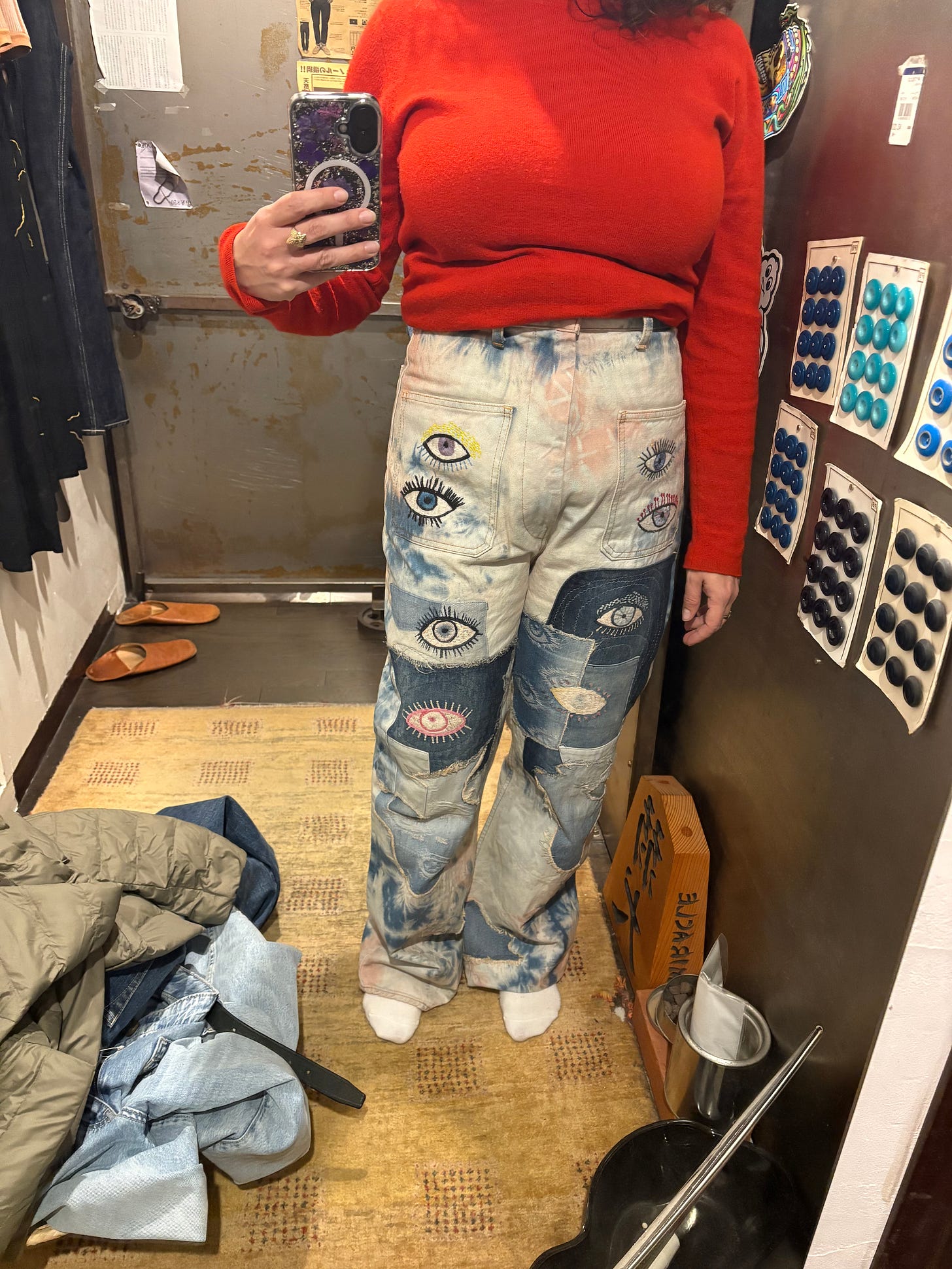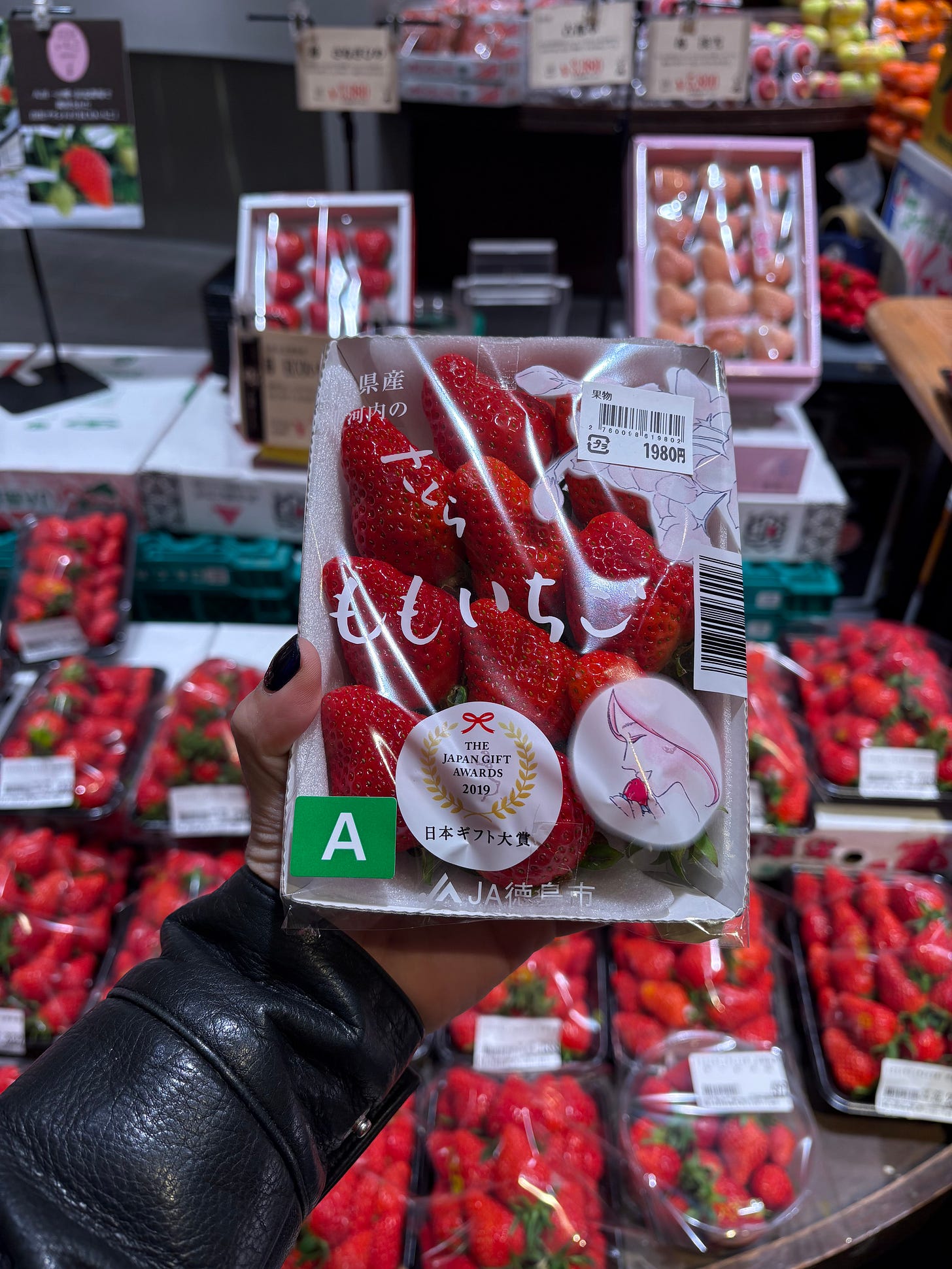Coping Mechanisms: Japan cont., etc.
Pack an extra suitcase. Perfect t-shirts, foreigner discount hacks, and Kyoto food heaven

Last edition of Coping Mechanisms opened with the Japanese concept of Shokunin - those unwavering in their act of striving towards perfection. This newsletter is not at that caliber of work, but I sincerely appreciate you reading all the same!
After returning from my Japanese dreams, the tsunami of real life crashed down on me hard. I manually jump-started my biological clock to do a cycle of egg freezing. The whole process made me feel like a voodoo doll, and put me in an indulgently lethargic state of couch potato. It enabled me to treat myself generously over the course that I had to poke myself multiple times a day to prepare for my reproductive organ harvest - each jab an excuse for me to counterbalance with something that would make me feel good momentarily. Sushi box delivery from Hi.Dozo, and emptying the vacation haul coffers of the kyoto mochi, strawberry sable cookies, and setouchi lemon seaweed snacks helped me persist. But instead of worrying about whether my eggs might be expired, I compulsively thought about the items that didn’t make into my checked luggage, e.g. the hand-stitched indigo slippers, and other ‘only in Japan’ things that I’ve been scouring online retailers for since.
I also watched the finale of White Lotus (twice, and listened to countless hours of analytical podcasts and cast interviews), The Studio (I have notes…let the lens find focus!), Love on the Spectrum (soulmates exist). And I’m so happy that I revisited The Wheel of Time series - specifically season 2, and then immediately binged season 3 on Amazon Prime. The fantasy show is rich in stories of heroes and anti-heroes on various quests, magic, palace intrigue, and it also has really gorgeous costume design that incorporates a lot of Japanese inspired textiles. The Wheel weaves as the Wheel wills is the most famous line from the books - and thank the light for the woven goods they’re dressing with, which have both inspired me and given me an idyllic escape right at home.
Little Stabs
While wandering the depachika (translation: basement food court) of Isaten Shinjuku, I bumped into a pop-up from Kuon Tokyo that makes new traditional Japanese pieces using local indigo dyes and weaves. Kuon carries intricately crafted, modern Sashiko and Boro clothing.
Sashiko translates to “little stabs.” The fitting name is a traditional embroidery technique that works well with patchwork, reinforcement or decoration that pierces my heart with its blueish beauty. Boro work has more of a quilting quality of that combines bits and bobs of fabric with visible mends, which may integrate sashiko stitches. It’s a distinctly wabi sabi aesthetic, but there are Shokunin sewists.
Kuon also produces pieces made by their special stitches ops division of women working known as the “Sashiko Gals,” that create nearly impossible to get, reworked shoe grails. I might never recover from missing out on this stitched up clog by personal fave sandal J-brand, Suicoke.


To buy or not to buy
Which leads me to a category of clothing that I’m dubbing as “shokunin chic.” These are the cherry blossoms you can don. That fleeting feeling of buying a souvenir can extend your dopamine kick when you wear it back at home. I write this while wearing a butter yellow deep v-neck tee that I had to buy after scouring the three different Kapital shops in Ebisu, and pumpkin orange Pleats Please Issey Miyake pants that I got for a 35% discount because I bought them in Kyoto. My case of the shoppies almost got me to buy a pair of patchy Kapital jeans, but I just couldn’t justify the cost per wear when this is how they fit me:
But now I find that they’re going for double the price online - Mr Porter.
Pro tip: even though every Kapital station has slightly different merchandise, you’re best bet is to shop at the two Roppongi locations because they will do tax-free.
Which leads me to why shopping tourism in Japan is so fun right now. Japanese brands are striving towards shokunin in their craft, and staying true to their traditional spirits of shape, drape and seasonality. Everything is at wagyu A5 kobe beef level, even a cotton t-shirt.
The best nighties ever
Did you know that most hotels in Japan supply guests with pajamas and loungewear to wear during their stay? Traditional ryokans will typically dress you in a yukata to wear to the onsen and at dinner. Wearing the full kit is not cultural appropriation, it’s respecting the culture.
I loved the gauzy lightweight “Kyo Wazarashi Mensya” set from the Ace Hotel Kyoto (by the legendary Daito Shingu, sleep experts since 1925).
The hotel Azumi Setado on Ikuchijima island in the Seto Inland Sea of Hiroshima has perfect 10 presentation across the board. Every single detail about the experience was sublime. Fwiw, the hotel is the independent pet project of the Aman Resorts founder. I could (and should) write an entire issue of this newsletter describing that hotel experience. But one standout element came home with me, the white t-shirt supplied in each room.
This slightly oversized, boxy, not too long not too short waist, mid-sleeve tee by Japanese underwear company, United Athle seems to look good on everyone. See image at the top of this for reference. And they are worn for every occasion of Azumi’s Setonaikai-inspired lifestyle; from lazing into the dining room by breakfast eaters, to the cyclist pilgrims cruising through on the Shimanami Kaido bike trail, to the uniform for entering and exiting the most beautiful public baths I’ve encountered throughout the country (pictured below).
I wore a size M at first, then asked the reception for a Small to compare. My travel companion wore a size L - and he looks better than the Chef on The Bear in it.
I was able to add mine to our room bills for $30 each. Of course I found a varietal online for Coping Mechanism readers and future Japan travelers, too. - Less than ~$50 on Amazon!
United Athle only has a Japanese info page here. But it’s a good resource for comparing knits weights, dimensions, colorways, etc.
Uniqlo makes a decent dupe for women using their Airism fabric. - $15 even in the USA!


Save $$$
Moreover, goods you buy in Japan directly from Japanese brands and makers cost less. First off, “tax-free!” is a mantra.
Important tip: Carry your passport and politely ask if they honor tax-free offers at every shop you visit before you close out. And gomenasai, because many have minimums, so go ahead and add those elusive kit kats to the basket.
Department stores like Mitsukoshi, Takashimaya, etc. have efficient refund desks for total purchases within the same day. Isetan offered an extra 5% off with a literal gaijin card (which I will keep in my wallet for eternity). You could buy luxury designer stuff, fancy skincare, pantry goods, and an extra suitcase all under one roof. Just make sure to visit the tax free station before exiting the building and ask for the credit back on your card for the best rate, which is worth it even though it’s not instant.
Don Quijote (Tokyo’s comp to City Target) deducts tax at checkout, but adopts the parisian pharmacie tactic of sealing purchased items into a bag that one is not supposed to open until after passing through customs…if you plan on making any claims.
As of publish time in the year 2025, for Americans, the Yen to Dollar exchange rate is outrageously in our favor, and buying on the ground avoids any recently induced foreign tariffs. Small brands are sure to suffer as a result of that prepostrous policy. And there are so many independent Japanese brands worth supporting. My must-shops are AndWander, Issey Miyake, Suicoke, Snow Peak, Onitsuka Tiger, and irresistibly, Uniqlo. And as
noted in their recently published Tokyo Guide 2025, some fab Japanese brands are available in the States but the prices are simply better on their home turf. They also recommend hunting for rare Auralee and A. Presse and Comoli and Cottle and also, OrSlow, Kaptain Sunshine, Slopeslow, Stein, Taiga Takahashi, Hender Scheme, Yoko Sakamoto, Graphpaper, Maatee & Sons, Ancellm, Bluhrms, Phigvel, and Yahae, among others.A good litmus test for retail markup is the cost of a pair of Onitsuka Tiger sneakers, or because I’m a hoarder collector of, the ‘monthly color’ Pleats Please trousers. If you find colorways you love and can afford, add them to your closet anytime, but if you can buy them in Japan - you might save $65-$150, respectively. IYKYK, it’s like buying Schostal PJ’s in Rome. There is joy in the experience AND the purchase.
Meanwhile, I’d be delighted if a Coping Mechanisms reader were enticed to buy this sunshiney glowy beauty orange body con shift dress from Mohawk LA? The sale price gets you nearly the same deal. This is not an affiliate promo, it’s just not right for my body.
How to Pack
Bring one smaller suitcase that fits within the another larger one. Pack the inner suitcase with the majority of what you’re bringing on the trip. Check as one piece of luggage. By the time you’re bursting at the seams, you can start using the extra bag.
And because you read this far, here’s a bonus rec for Kyoto:
Yaoichi Honkan Kyoto - Japanese grocery stores are my happy place and this Kyoto shop is top grade pressed pill ecstasy. There is a fresh produce market where you can buy all of the fancy fruit for lower prices than Erewhon. The prepared food section and a take-out bakery will make you want to fill up that cafeteria tray. Listen to that impulse. It’s the perfect place to procure a picnic to sit along the Kamo river (say that 5x fast). There is also roasted sweet potato/ice cream stand on the ground level - soft sosweets for every season. Go gift shopping crazy with the home goods and pantry items up a floor, and then finally, don’t leave until you’ve seen their functional rooftop farm. MAP
Temporal Nature
Should one encounter the deliverance of a Shokunin output
one must wonder, might one become enlightened
by acquiring the paramount demonstration of specific material goods, or by the ephemeral pleasure
of tasting a thoughtfully, deliberately composed bite?
The answer we know, is no
but it is fun to get on with it anyways.
There’s always the wabi sabi philosophy to fall back on.






